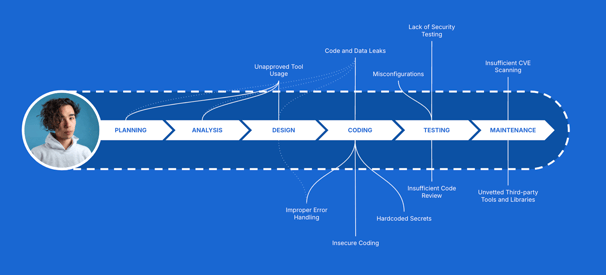Developer SIEM enhances traditional SIEM systems by focusing specifically on the security, compliance, and actions of developers. Unlike conventional SIEMs, which monitor security events across IT systems, Developer SIEM centralizes data related to developer activities, tools, and workflows. This provides a historical, compliance-ready overview of risks introduced during the development process.
Organizations can use Developer SIEM to:
Link Developer Actions to Vulnerabilities: Understand how developer activities, such as the use of unapproved tools or insecure coding practices, contribute to security risks within codebases and toolchains.
Enable Post-Incident Forensics: Retain comprehensive logs and records to investigate vulnerabilities, pinpoint root causes, and ensure accountability.
Simplify Compliance Tracking: Create developer-specific audit trails in line with regulatory requirements like NIST SSDF and SOC 2.
Visualize Security Trends: Identify recurring issues and improve secure development practices through in-depth analysis.
Data Collection:
Developer SIEM aggregates information from a range of sources, such as:
Developer tools like IDEs (e.g., VSCode, IntelliJ).
CI/CD pipelines (e.g., GitHub Actions, GitLab CI).
Version control systems (e.g., Git).
Developer actions including code commits, pull requests, and AI-assisted coding.
Event Correlation:
The collected data is analyzed alongside:
Vulnerability scanning tools (e.g., SAST, SCA, IaC).
Compliance policies to detect deviations from approved tools or coding standards, including internal guidelines.
Broader IT security incidents, providing a unified context for incident response.
Incident Investigation and Forensics:
Developer SIEM maps vulnerabilities and risks to specific developer actions, creating detailed audit trails for root cause analysis and governance.
Several notable incidents underscore the importance of Developer SIEM in managing risks arising from developer actions and weak security postures:
Insider Threats and Identity Mismanagement, Uber Breach (2022):
A hacker exploited compromised developer credentials to access critical systems, emphasizing the need for proactive monitoring of developer activity to detect and mitigate insider threats before they escalate.AI Code Vulnerabilities, GitHub Copilot Security Flaw (2024)
Researchers discovered that AI tools like GitHub Copilot can generate insecure code snippets when working with flawed codebases. This highlights the importance of governing AI-driven code development and detecting insecure code patterns in real-time.
These incidents highlight why Developer SIEM is essential for securing the development lifecycle, enabling organizations to swiftly address vulnerabilities introduced by developer actions.
These incidents demonstrate why Developer SIEM is indispensable for securing the development lifecycle, enabling organizations to address vulnerabilities introduced by developer actions swiftly and effectively.
The Archipelo SDLC Developer Security and Compliance Platform takes a developer-first approach to securing the SDLC, with capabilities designed to provide real-time risk detection and actionable insights:
DevSIEM & DevDR Track Events & Generate Actionable Insights: Proactively monitor and mitigate software security risks caused by developers throughout the SDLC.
Automated Developer & CI/CD Tool Governance: Scan developer and CI/CD tools to verify tool inventory and mitigate shadow IT risks with developers.
AI Code Usage & Risk Monitor: Monitor AI code tool usage to ensure
secure and responsible software development and innovation.
Developer Security Posture: Monitor security risks of developer
actions providing insights on their behavior and security posture.
By providing these capabilities, Archipelo empowers organizations to protect their SDLC, reduce insider threats, and strengthen software security.
Archipelo redefines traditional developer monitoring by establishing a proactive, security-focused framework to ensure governance across the SDLC. Key benefits include:
Unified Visibility: Gain comprehensive insights into developer-related risks across tools, workflows, and environments.
Enhanced Compliance: Automatically generate detailed, audit-ready reports for regulatory and organizational standards.
Streamlined Operations: Reduce operational complexity with automated log aggregation, analysis, and event correlation.
Continuous Improvement: Use historical analysis to identify patterns, improve processes, and foster secure coding practices.
With Archipelo's Developer SIEM, organizations can build a secure development foundation, mitigating risks introduced at the code level while fostering compliance and accountability across teams.
Contact us to learn how Archipelo can help secure your SDLC while aligning with DevSecOps principles.


